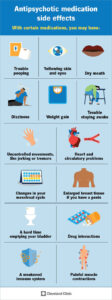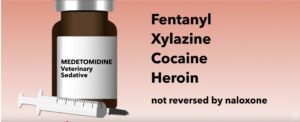
There was an article published on February 8th on a “health crisis” in Cyprus because a so-called crucial psychiatric medication, Seroquel XR, has not been available for six months. This resulted in previously stable patients to become bedridden and unable to do their daily social and work responsibilities. The said shortage has forced patients to switch to less effective alternatives. The extended-release formula cannot be effectively replaced by immediate-release forms of quetiapine (Seroquel), because they cause severe drowsiness, leaving many patients bedridden. Two days later, the Health Insurance Organization in Cyprus announced Seroquel XR would be available in pharmacies by February 14th.
There were also reports of shortages of quetiapine in Australia and Canada. In Australia, it was reported pharmaceutical companies blamed manufacturing constraints and said other generic medications were available. The Canadian drug report history indicated there had been a “disruption of the manufacture of the drug,” and the shortage was estimated to end by March 31st. What’s going on?
Causes of Drug Shortages
Drug shortages have been periodically occurring in the U.S. for the past few decades. In 2011, “The Drug Shortage Crisis in The United States” noted these shortages significantly burden health care providers and health care facility finances and personnel. Manufacturers provide little advance notice (or any notice) of an impending drug shortage, and give no estimate of the duration of the drug shortage. Without advanced warning of an impending drug shortage, the FDA can only become engaged after a shortage begins. Early notification allows the FDA to work with companies to address the potential shortages quickly, as such actions averted 38 shortages in 2010.
There are a variety of reasons for drug shortages including manufacturing problems, supply/demand issues, as well as business and economic issues. Manufacturer’s business decisions influence drug shortages because of insufficient profits, market share, mergers, patent expiration, and the expense to correct manufacturing problems. They may permanently or temporarily reduce production of certain drugs in order to shift production or reallocate resources to another product, potentially leading to a new drug shortage. Many of the drugs (like antipsychotics) in short supply tend to be generic medications, which aren’t very profitable. This leads to companies maintaining lower inventories of low-profit drugs or discontinuing them—taking them off the market.
Most drug shortages that occur in the U.S. involve generic medications. These shortages likely occur because manufacturers have little financial incentive to produce off-patent medications. At most, only a few manufacturers produce a particular generic drug, so shortages are inevitable. Shortages of drug classes containing mostly generic drugs, including anesthetics, antibiotics, and cancer treatments, have tripled since 2006. Companies may also decide to discontinue production of a trade-name drug once it comes off-patent, and the need to produce an additional product also strains the capacity of generic drug manufacturers.
Some industry representatives blame increased FDA oversight for the drug shortages. But the FDA disputes that government oversight in to blame, saying manufacturing problems are the cause of most shortages. Data supports this contention, with manufacturing difficulties accounting for 28% of known reasons for drug shortages, while regulatory issues account for the fewest (1%).
Drug shortages do occur when an FDA enforcement action for non-compliance with current good manufacturing practices (cGMPs) causes the primary or sole manufacturer of a drug to halt or delay production. Subcontractors that supply products to pharmaceutical manufacturers can also be subject to cGMP violations. Resolution of such issues is often a lengthy process and may require FDA inspections for recertification, issuance of an injunction against the manufacturer, or seizure of products.
Also, most manufacturers, distribution centers, and health care systems now use “just-in-time” inventory management to optimize cash flow and reduce the cost of inventory stock. This can increase the vulnerability of health care systems to unexpected drug shortages. Manufacturers and distribution centers can also use management strategies to reduce inventories or limit shipments according to yearly quotas.
Poor ordering practices, drug stockpiling in advance of price increases, hoarding in response to rumors of an impending shortage, and delivery delays may also affect drug stock inventories in health care facilities. Drug shortages may also occur when too many health care facilities in a geographic area are using the same wholesaler, particularly since some shortages are wholesaler-dependent and may occur only because of delays in supplier contracts.
“The Drug Shortage Crisis in the United States” concluded that the increasing frequency of drug shortages created complex challenges for health care providers and facilities. They have a profound impact on patient safety, quality control health care management and other factors. While there is no crystal ball to predict or prepare for drug shortages, careful planning can prevent them from turning into a crisis. The establishment of clear procedures and guidelines to manage drug shortages is needed. “Proper information-gathering, extensive collaboration, and timely communication strategies are critical elements of an effective drug shortage management plan.”
Keep in mind that although this article’s recommendations were written in 2011, they don’t seem to have been acted on yet; given the above discussion on the Seroquel shortage.
First and Second-Generation Antipsychotics
The adverse side effects from older antipsychotics like Thorazine and Haldol led to the development of others, which had their own side effects. Antipsychotics, like all drugs, have side effects. In her book Never Enough, Judith Grisel referred to this as the second law of psychopharmacology. Drugs, whether they are pharmaceutical or recreational, unlike neurotransmitters, are not targeted in their delivery to precise cells or brain circuits. They act at all accessible targets. “Therefore, if you take a drug to modify mood, it will also produce side effects in other motived behaviors such as sleeping and sex.”
For more information on Judith Grisel and Never Enough, see “Never Enough and No Free Lunch” and “Never Enough and Adaptation.”
Antipsychotic or neuroleptic medications are used to treat symptoms associated with psychosis. Many symptoms such as delusions, hallucinations, paranoia and hearing voices can be reduced or controlled by antipsychotics. The two classes of currently marketed medications are first and second-generation antipsychotics. First-generation or typical antipsychotics (FGAs) primarily block dopamine receptors and include drugs like chlorpromazine (Thorazine), fluphenazine (Prolixin), haloperidol (Haldol), and perphenazine (Trilafon).
Second-generation or atypical antipsychotics (SGAs) don’t work like typical antipsychotics. Rather, they only partially block dopamine receptors and may affect other neurotransmitters like serotonin. They include drugs like quetiapine (Seroquel), aripiprazole (Abilify), clozapine (Clozaril), and olanzapine (Zyprexa), which are all generics. Additional atypicals include: asenapine (Saphris), brexpiprazole (Rexulti), cariprazine (Vraylar), iloperidone (Fanapt), lurasidone (Latuda), paliperidone (Invega), risperidone (Risperdal), and ziprasidone (Geodon). Geodon has been approved as a generic as of January 8, 2025, but there hasn’t been a generic announced yet.
The biggest difference between FGAs and SGAs involves side effects. FGAs tend to affect your body movement more than SGAs. They may cause movement problems like muscle stiffness. They may lead to more serious movement disorders. SGAs are less likely to affect your body movement but more likely to lead to weight gain and metabolic changes.
Studies show they both have about the same level of effectiveness with schizophrenia and about the same quality of life. However, some medications work better for some people and some are more tolerable than others, depending upon the person. Individuals being treated with antipsychotics should weigh the risks and benefits of the medication prescribed to them, its potential side effects and then monitor how they respond to the drug. This is consistent with what psychiatrist Jonna Moncrief calls the drug-centered model of drug action. Also see “Pros and Cons of Antipsychotics.”
According to the Cleveland Clinic, weight gain and drowsiness are side effects common to quetiapine and most other second-generation antipsychotics. Various additional side effects include: constipation, headache, dry mouth and others. Side effects with quetiapine and other second-generation antipsychotics that should be reported to your care team include: new or worsening depression or thoughts of suicide, increased blood sugar, problems controlling your body temperature, and dizziness or drowsiness. See the following chart.
Prevalence of Psychosis and the Antipsychotic Drug Market
According to Jordan Calabrese and Yasir Al Khalili in “Psychosis” for the National Library of Medicine, psychosis describes a combination of psychological symptoms that result in a loss of contact with reality. An estimated 1.5% to 3.5% of people meet the diagnostic criteria for a psychotic disorder, and a further number of people will experience at least one psychotic symptom in their lifetime. It is a common feature of with many psychiatric, neurologic and medical conditions. It is the central feature of schizophrenia spectrum and other psychotic disorders, as well as a co-occurring aspect to several mood and substance use disorders.
Psychosis may result from a primary psychiatric illness, substance use, or another neurologic or medical condition. Brain abnormalities have correlated with first-episode psychotic disorders, including reduced prefrontal, superior, and medial temporal grey matter. Primary psychotic disorders are considered neurodevelopmental abnormalities and believed to develop in utero, although many times the manifestation of psychotic symptoms and full-blown illness correlate with epigenetic or environmental factors (substance abuse, stress, immigration, infection, postpartum period, or other medical causes). There is significant evidence for genetic risk factors in the pathogenesis of psychotic disorders.
The incidence of first-time psychosis is about 50 in 100,000 people, while the incidence of schizophrenia is roughly 15 in 100,000 people. It can result in high levels of distress for patients and family, making it a primary treatment for medical professionals. The peak age for males is teens to mid-20s, and teens to late-20s for females. Early onset is associated with poorer outcomes, but early intervention correlates with better results. This leads to a sought-after market of long-term patients needing to use the above listed first and second-generation antipsychotics.
Towards Healthcare estimated the antipsychotic drug market to be $18.04 billion in 2023, growing to $37.4 billion by 2032. Second-generation antipsychotics like quetiapine had a 65% market share in 2023. North America led with 37% of the market in 2023. “Schizophrenia was the most widely treated disorder with antipsychotic drugs in 2023, reporting the largest market share (52%) in 2023.” Given the influence of business and marketing decisions on the availability of various antipsychotics, expect ongoing times of ups and downs to continue.






